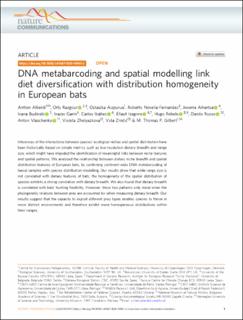| dc.contributor.author | Alberdi, Antton | |
| dc.contributor.author | Razgour, Orly | |
| dc.contributor.author | Aizpurua, Ostaizka | |
| dc.contributor.author | Novella-Fernandez, Roberto | |
| dc.contributor.author | Aihartza, Joxerra | |
| dc.contributor.author | Budinski, Ivana | |
| dc.contributor.author | Garin, Inazio | |
| dc.contributor.author | Ibáñez, Carlos | |
| dc.contributor.author | Izagirre, Eñaut | |
| dc.contributor.author | Rebelo, Hugo | |
| dc.contributor.author | Russo, Danilo | |
| dc.contributor.author | Vlaschenko, Anton | |
| dc.contributor.author | Zhelyazkova, Violeta | |
| dc.contributor.author | Zrncic, Vida | |
| dc.contributor.author | Gilbert, Marcus Thomas Pius | |
| dc.date.accessioned | 2021-02-19T07:20:09Z | |
| dc.date.available | 2021-02-19T07:20:09Z | |
| dc.date.created | 2021-01-11T11:13:57Z | |
| dc.date.issued | 2020 | |
| dc.identifier.citation | Nature Communications. 2020, 11 . | en_US |
| dc.identifier.issn | 2041-1723 | |
| dc.identifier.uri | https://hdl.handle.net/11250/2729057 | |
| dc.description.abstract | Inferences of the interactions between species’ ecological niches and spatial distribution have been historically based on simple metrics such as low-resolution dietary breadth and range size, which might have impeded the identification of meaningful links between niche features and spatial patterns. We analysed the relationship between dietary niche breadth and spatial distribution features of European bats, by combining continent-wide DNA metabarcoding of faecal samples with species distribution modelling. Our results show that while range size is not correlated with dietary features of bats, the homogeneity of the spatial distribution of species exhibits a strong correlation with dietary breadth. We also found that dietary breadth is correlated with bats’ hunting flexibility. However, these two patterns only stand when the phylogenetic relations between prey are accounted for when measuring dietary breadth. Our results suggest that the capacity to exploit different prey types enables species to thrive in more distinct environments and therefore exhibit more homogeneous distributions within their ranges. | en_US |
| dc.language.iso | eng | en_US |
| dc.publisher | Nature Research | en_US |
| dc.rights | Navngivelse 4.0 Internasjonal | * |
| dc.rights.uri | http://creativecommons.org/licenses/by/4.0/deed.no | * |
| dc.title | DNA metabarcoding and spatial modelling link diet diversification with distribution homogeneity in European bats | en_US |
| dc.type | Peer reviewed | en_US |
| dc.type | Journal article | en_US |
| dc.description.version | publishedVersion | en_US |
| dc.source.pagenumber | 8 | en_US |
| dc.source.volume | 11 | en_US |
| dc.source.journal | Nature Communications | en_US |
| dc.identifier.doi | https://doi.org/10.1038/s41467-020-14961-2 | |
| dc.identifier.cristin | 1868748 | |
| dc.description.localcode | Open Access This article is licensed under a Creative Commons Attribution 4.0 International License, which permits use, sharing, adaptation, distribution and reproduction in any medium or format, as long as you give appropriate credit to the original author(s) and the source, provide a link to the Creative Commons licence, and indicate if changes were made. The images or other third party material in this article are included in the article’s Creative Commons licence, unless indicated otherwise in a credit line to the material. If material is not included in the article’s Creative Commons licence and your intended use is not permitted by statutory regulation or exceeds the permitted use, you will need to obtain permission directly from the copyright holder. To view a copy of this licence, visit http://creativecommons.org/licenses/by/4.0/. | en_US |
| cristin.ispublished | true | |
| cristin.fulltext | original | |
| cristin.qualitycode | 2 | |

